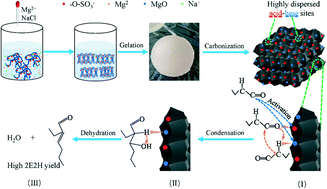One-pot synthesis of biomass-derived porous carbon-based composites as an efficient acid–base bifunctional catalyst for self-condensation of n-butyraldehyde†
Abstract
Although self-condensation of n-butyraldehyde (NBD) was widely investigated over various types of catalysts, the main challenge we face is inefficiency due to their small surface area and/or single property. The single property is mainly manifested in the fact that the previous catalysts are mainly based on the acidic site or the basic site. A series of carbon-based composites with acid–base functions and porous structures were successfully prepared by using carrageenan as a carbon source via a simple method in this work. Highly dispersed basic sites and acid sites were simultaneously fabricated by introducing MgO through the strong interaction between Mg2+ and functional groups and in situ transformation of highly dispersed acid groups in the carrageenan molecule during the preparation process, respectively. Characterization results indicated that the synthesized material possesses a large surface area which is ascribed to the formation of rich pores templated with the inorganic salt. The catalytic performance tests show that the obtained composite is an efficient catalyst for the self-condensation of NBD, which gives a 90.0% conversion of NBD and a 96.6% selectivity to 2-ethyl-2-hexenal with only 1.0 wt% catalyst in a relatively short reaction time of 4 h. A possible synergistic mechanism was proposed to reveal why the synthesized acid–base bifunctional material displayed an excellent performance in catalyzing aldol condensation.



 Please wait while we load your content...
Please wait while we load your content...